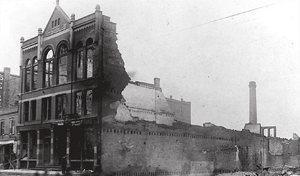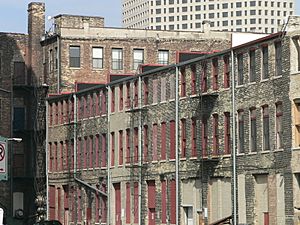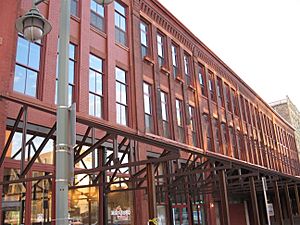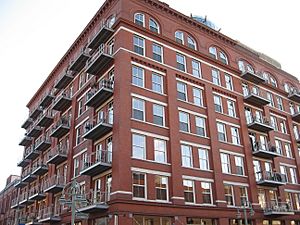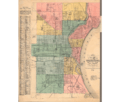Historic Third Ward, Milwaukee facts for kids
Quick facts for kids |
|
|
Historic Third Ward District
|
|
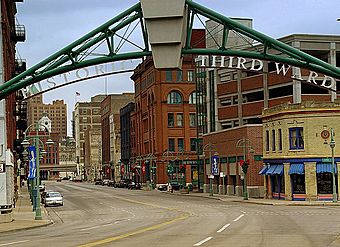
Third Ward Neighborhood
|
|
| Location | Milwaukee, Wisconsin |
|---|---|
| Built | 1875 |
| Architect | Multiple |
| Architectural style | Late Victorian |
| NRHP reference No. | 84003724 |
| Added to NRHP | March 8, 1984 |
The Historic Third Ward is a special old warehouse district in downtown Milwaukee, Wisconsin. This Milwaukee neighborhood is officially listed on the National Register of Historic Places. Today, the Third Ward is a busy place with over 450 businesses. It's known for its many unique shops, tasty restaurants, cool art galleries, and theater groups. You'll also find creative businesses and homes here. It's home to the Milwaukee Institute of Art and Design (MIAD) and the Broadway Theatre Center. The Ward is also right next to the Henry Maier Festival Park, where Summerfest happens. The district is surrounded by the Milwaukee River to the west and south, E. St. Paul Avenue to the north, and N. Jackson Street to the east.
Contents
History of the Third Ward
Early Days and Challenges
Long ago, the Third Ward was a flat, wet area, almost like a swamp. People worked to drain the land, and soon houses appeared on the west side. Factories and warehouses were built along the Milwaukee River. Many early settlers were Irish immigrants. The area even got the nickname "Bloody Third" because there were often fistfights.
In 1856, the first railroad connected Milwaukee to the Mississippi River. This helped businesses in the Third Ward send goods to settlers in the West.
The Irish community in the Third Ward faced two big tragedies. On September 7, 1860, the Lady Elgin steamship left Milwaukee. It carried many people from the Third Ward's Irish community. More than 400 people are thought to have died when the ship sank. This was one of the biggest losses of life on the Great Lakes. A special marker in the Third Ward remembers this event. There is also a monument at Calvary Cemetery.
The second tragedy happened on October 28, 1892. A fire started by accident at the Union Oil & Paint Co. building. Strong winds, up to 50 miles per hour, quickly spread the fire. It grew out of control. Firefighters from nearby cities like Chicago and Racine came to help. In total, 440 buildings were destroyed. More than 1,900 people, mostly Irish families, lost their homes. They found shelter in schools and churches. Victims also received food and clothing.
Rebuilding and New Communities
After the 1892 fire, many local architects helped design new commercial buildings. Construction continued for 36 years. This gave the neighborhood a similar look because the buildings were built around the same time.
During this rebuilding period, Italian immigrants began to move into the Third Ward. Many Irish families had moved to other parts of the city. The Italian community became very active in the warehouse businesses. They created "Commission Row," which was a group of grocery businesses. By 1915, the Ward had many Italian groceries and even two spaghetti factories! Grocery warehouses, drink distributors, and manufacturers thrived here.
Changes and Modern Revival
In the 1960s, new highway construction caused the close-knit Italian community to move. The growth of trucking and suburbs also led to fewer warehouse businesses. Sadly, the Blessed Virgin of Pompeii Catholic Church, a Milwaukee landmark, was torn down in 1967 for the I-794 freeway.
In 2000, the Historic Third Ward Association started helping with Gallery Night and Day. This art event happens four times a year and brings thousands of visitors to the neighborhood. The Third Ward has recently seen many new upscale shops, restaurants, and home furnishing stores. The Milwaukee Public Market also offers gourmet and specialty food shopping all year round.
In 2010, Erie Street Plaza opened. This small park was built on what used to be a parking lot. It's on the southern edge of the neighborhood, where the Milwaukee River meets the Kinnickinnic River.
In 2019, two European artists created murals in the area. French artist MTO painted murals about endangered species. Later that summer, German artist Case Maclaim painted "The Unsung Hero." This huge six-story mural is a popular sight for visitors.
Recent Milestones
- 1980s:
* The "Historic Third Ward District" was officially recognized. It included 70 buildings across about 10 city blocks. * MIAD moved to its current location. * The Buffalo Street Bridge was removed. This made the Third Ward a bit more isolated, which helped keep its unique feel.
- 1990s:
* A $3.4 million project improved the streets. Two new parking garages were also built, helping the area's economy. * New buildings started to appear, not just renovations. * The riverwalk was created, connecting downtown and the Third Ward.
- 2000s:
* The Milwaukee Public Market opened. * Plans for a new hotel showed how the neighborhood was changing. * Construction and renovation spread south of the river, creating a new Fifth Ward. * The "Unsung Hero" mural was painted.
Historic Buildings
In 1984, many of the Third Ward's old warehouses and industrial buildings were named a historic district. These buildings were mostly built between 1892 and 1928. The district is bordered by the Milwaukee River, I-94, and some newer warehouses. Here are some of the important buildings:
- The Wirth, Hammel & Co. Sales Stable at 167 N. Broadway: This 2-story horse stable was built in 1892. It replaced a stable that burned in the fire. They sold horses for work and riding. The stable could hold 150 horses! Later, it became an auto sales and service business.
- The Milwaukee Fire Department Engine Company #10 at 176 N. Broadway: This 3-story fire station was built in 1893. It replaced the old station destroyed by the 1892 fire. It has a classic Queen Anne design.
- The National Distilling Co. at 221 E. Buffalo Ave.: This 4-story office building was built in 1893. It was likely used for offices and storage for a company that made spirits. During Prohibition (when alcohol was illegal), the company changed its name to Red Star Yeast and made industrial alcohol and yeast.
- Wellauer & Hoffman Co. at 232 N. Broadway: This 6-story building was built in 1893-94. It was home to wholesale grocers and coffee roasters. Later, it housed a men's clothing manufacturer and a furniture showroom.
- The Ludington Estate Commission Houses at 301-315 N Broadway: This 3-story brick building was built from 1894 to 1895. It was a busy center for wholesale groceries, fruits, and flowers well into the 1980s.
- Roundy, Peckham & Dexter Co. at 241 N. Broadway: This 6-story warehouse was built in 1895. The company started as a wholesale grocer. Their original store burned in the 1892 fire. In this new building, they imported groceries, packed grains, and roasted coffee. In 1952, the company became Roundy's Inc.
- The Baumbach Building at 302 N. Broadway: This 5-story factory was built in 1899. It first housed a company that made clothes for lumberjacks and miners. Later, it was used by a knitting company and a lamp manufacturer.
- The American Candy Co. at 191 N Broadway: This 7-story building was built in 1902. The candy company made chocolates and other sweets. Later, it was used as a warehouse by Boston Store and then by a company that processed war materials.
- The E.R. Godfrey & Sons Co. at 402 N. Broadway: This 8-story building was built in 1911. Godfrey Co. was a grocery wholesaler. They claimed to be the first to combine wholesale groceries with fresh produce in the Third Ward. They also roasted their own coffee. In 1926, James Godfrey founded IGA supermarkets. Later, the building housed a printing company and a musical instrument business.
- The Marine Terminal Building Warehouse at 120 N. Broadway: This 3-story warehouse was built in 1917-18. It's right on the Milwaukee River, making it easy to access by road, lake, and downtown. It has been used as a dock, warehouse, and offices for many different businesses.
Education
The schools in this area are part of Milwaukee Public Schools.
Photos of the Third Ward
Images for kids




